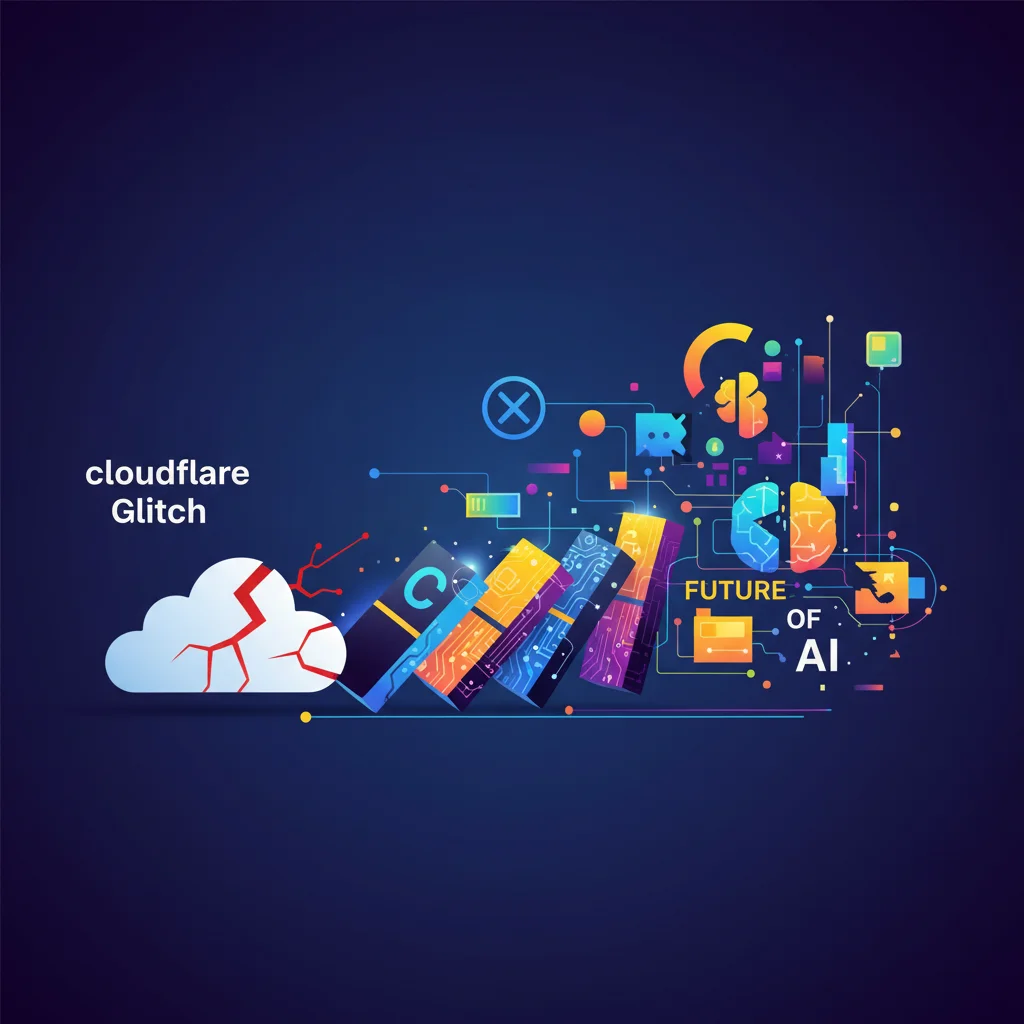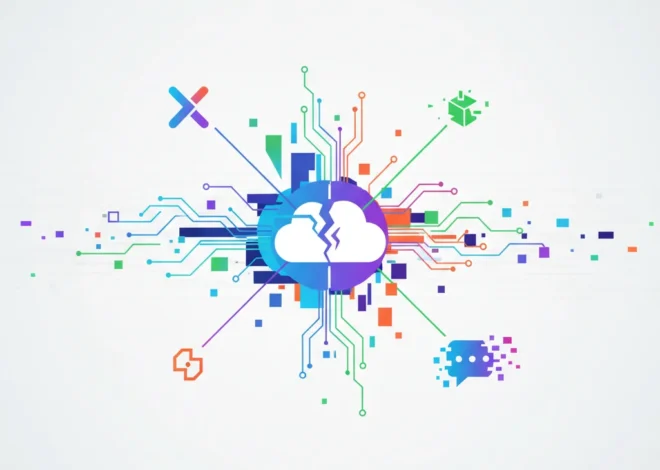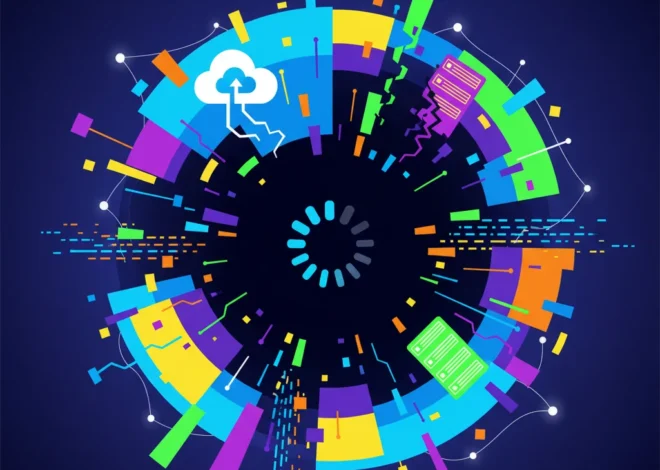
The Digital Domino Effect: How One Cloudflare Glitch Silenced ChatGPT and the Future of AI
It started subtly. A chatbot that wouldn’t respond. A social media feed that refused to refresh. For a few hours on a seemingly ordinary day, two of the internet’s giants, OpenAI’s ChatGPT and Elon Musk’s X, stumbled. The cause wasn’t a bug in their own sophisticated code or a failure in their massive server farms. The culprit was a single, critical link in the global internet chain: Cloudflare.
The San Francisco-based company, a titan of online security and performance, experienced an outage that sent ripples across the digital landscape. According to a report from the Financial Times, the incident was blamed on a “spike in unusual traffic” to one of its services. While the technical issue was eventually resolved, the event served as a stark reminder of a fundamental truth we often forget: the revolutionary world of artificial intelligence, complex software, and global communication rests on a surprisingly fragile foundation.
This wasn’t just another tech hiccup. It was a stress test for the digital age, revealing the hidden dependencies that underpin our daily lives and the burgeoning AI economy. For developers, entrepreneurs, and tech leaders, this event is more than a news story—it’s a critical case study in resilience, risk, and the architectural choices that will define the next wave of innovation.
Deconstructing the Outage: What is Cloudflare and Why Does It Matter So Much?
To understand the magnitude of this event, you first need to understand Cloudflare’s role in the internet ecosystem. Think of Cloudflare as the internet’s ultimate middleman—in the best way possible. It’s a massive global network that sits between a user (you) and the website or application you’re trying to reach (like ChatGPT).
Cloudflare provides several critical services:
- Content Delivery Network (CDN): It caches website content on servers all over the world, so when you access a site, you’re loading it from a server near you, making it much faster.
- DNS Services: It translates human-readable domain names (like google.com) into machine-readable IP addresses, acting as the internet’s phonebook.
- Cybersecurity Shield: It’s a frontline defense against malicious attacks, most notably Distributed Denial of Service (DDoS) attacks, which try to overwhelm a service with junk traffic.
When a company like Cloudflare has a problem, it doesn’t just affect one website. It affects a significant percentage of the entire internet. The official cause, a “spike in unusual traffic,” is a deceptively simple phrase. This could mean anything from a misconfigured piece of automation software sending millions of accidental requests to a sophisticated, targeted cyberattack. Regardless of the intent, the result was the same: a critical service buckled, and the services relying on it fell like dominoes.
The Blast Radius: Visualizing a Single Point of Failure
The core lesson here is the danger of a Single Point of Failure (SPOF). While the internet was designed to be a decentralized network, the modern cloud economy has led to a re-centralization around a few key infrastructure providers. When one of these pillars shakes, the whole building trembles.
The table below illustrates the chain reaction that occurs during an infrastructure outage like this, showing how a problem in one core service can have a cascading impact on businesses and end-users.
| Layer of Failure | Technical Impact | High-Profile Services Affected | End-User Experience |
|---|---|---|---|
| Core Infrastructure (Cloudflare) | A specific service (e.g., security, routing) fails due to a traffic spike. | N/A (The source of the problem) | Invisible to the end-user initially. |
| Dependent SaaS Platforms | Inability to resolve DNS, block malicious traffic, or serve content efficiently. The application becomes unreachable or unstable. | OpenAI (ChatGPT), X (formerly Twitter) | “ChatGPT is at capacity right now,” error messages, infinite loading screens, inability to post or view content. |
| Second-Order Businesses | Startups and developers relying on ChatGPT’s API for their own products see their services fail. Marketing teams using X for campaigns are grounded. | Countless smaller apps, content creation tools, customer service bots. | Your favorite AI-powered writing assistant stops working. A company’s automated support chat goes offline. |
| Broader Economic Activity | Productivity loss for millions of professionals who use these tools for coding, writing, and research. Temporary halt in digital marketing and communication. | Professionals in every industry, from programming to marketing. | “I can’t finish my report because the research tool I use is down.” |
As the table shows, the failure wasn’t with the artificial intelligence itself, but with the delivery mechanism. This distinction is crucial for understanding where the modern internet’s vulnerabilities lie.
The £5 Billion Bitcoin Heist: How AI and Cybersecurity Are Battling a New Era of Digital Crime
For Startups and Developers: Turning a Crisis into a Teachable Moment
While it’s easy to point fingers, the more productive approach is to learn. For any entrepreneur running a SaaS business or a developer building the next great app, this outage offers invaluable, if painful, lessons in building resilient systems.
1. Embrace Graceful Degradation
Your application should not completely collapse when a third-party dependency fails. Implement “graceful degradation,” where the user experience might be limited, but the core functionality remains. For example, if an AI summarization feature fails, can the user still view the full article? If a social media login API is down, can users still log in with an email and password? This requires proactive programming and architectural foresight.
2. Re-evaluate Your Redundancy Strategy
Putting all your eggs in one basket is risky. While using a single provider like Cloudflare or AWS is simpler and often cheaper, it creates a SPOF. Startups should at least consider:
- Multi-CDN: Using two or more CDN providers and intelligently routing traffic based on performance and availability.
- Multi-Cloud: A more complex and expensive strategy, but one that provides the ultimate resilience by distributing infrastructure across different cloud providers.
The key is to weigh the cost of downtime against the cost of redundancy. For a mission-critical application, the latter is almost always a worthwhile investment.
3. Master Your Monitoring and Incident Response
You can’t fix what you can’t see. Robust monitoring isn’t just about knowing if your server is up; it’s about tracking the performance of every critical third-party API and service you rely on. When an outage like this occurs, your team needs a well-rehearsed incident response plan. Who communicates with customers? How do you failover to a backup system? Quick detection and response can turn a major crisis into a minor inconvenience for your users.
The EU's New Intelligence Hub: A Big Data Challenge or a Cybersecurity Nightmare?
The Future is Resilient: Cybersecurity, AI, and the Next-Generation Cloud
This incident, affecting major platforms like ChatGPT and X (source), pushes the conversation about internet architecture into the mainstream. It forces us to ask tough questions about the trade-offs between speed, cost, and stability. The future of innovation, especially in resource-intensive fields like AI and machine learning, depends on a more robust and resilient internet.
We are likely to see accelerated development in several key areas:
- Decentralized Technologies: While still nascent, projects exploring decentralized computing and content delivery aim to create an internet with no single point of failure.
- Smarter Automation: The next frontier in cybersecurity and network management is AI-powered automation that can predict and reroute traffic around potential outages before they even happen.
- Edge Computing: By processing more data closer to the end-user (at “the edge”), applications can reduce their reliance on centralized cloud data centers, offering both speed and resilience benefits.
The path forward requires a mindset shift. Resilience can no longer be an afterthought or a feature for “enterprise-tier” plans. It must be a foundational design principle for any serious digital product or service.
Conclusion: Beyond the Glitch
The brief silence of ChatGPT and X was more than a momentary inconvenience. It was a clear signal that the digital infrastructure supporting our modern world is both incredibly powerful and precariously balanced. The incident at Cloudflare wasn’t the first of its kind, and it certainly won’t be the last. But for every developer, entrepreneur, and tech leader, it should serve as a powerful catalyst for change.
Building the future, especially one intertwined with the transformative power of artificial intelligence, requires more than just brilliant code and innovative algorithms. It requires building on a foundation of rock, not sand. It demands an obsession with reliability, a commitment to resilience, and the foresight to plan for the day when even the biggest clouds have a rainy day.


